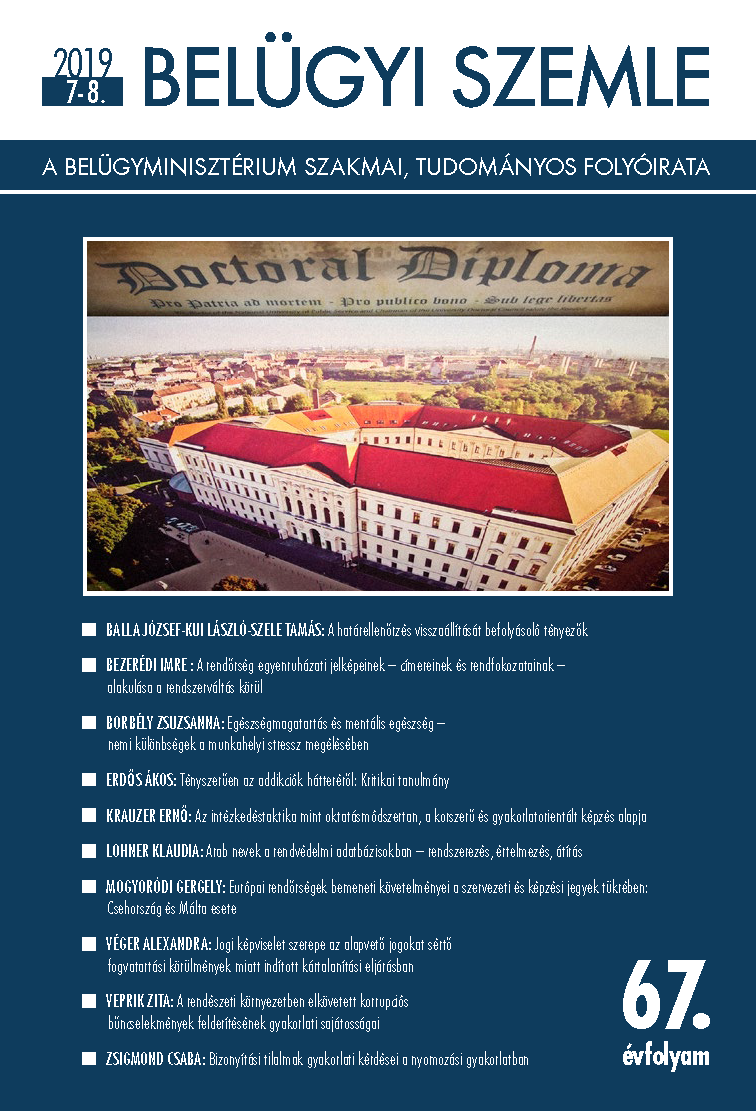Keywords
arabic names
identify
database
migration
identify
database
migration
How to Cite
Arab nevek a rendvédelmi adatbázisokban – rendszerezés, értelmezés, átírás. (2019). Academic Journal of Internal Affairs, 67(7-8), 117-132. https://doi.org/10.38146/BSZ.2019.7-8.6
Abstract
The continuously growing presence of Arabic culture in Europe raises new challenges for Hungary. Diverse variety of law enforcement’s expertise are contained by these challenges. In order to find a proper solution to these challenges of immigration, it is necessity for the law enforcement agencies to get familiar with the Arabic culture and their way of thinking, understand the structure of Arabic names; moreover, we have to get to know the problematic situation of the transcription of Arabic names. All these are essential for the highest level of efficiency at law enforcement agencies.
Downloads
Download data is not yet available.
Similar Articles
- László András Szabó, Europe and migration , Academic Journal of Internal Affairs: Vol. 67 No. 10 (2019)
- Kálmán Etter, Zsolt Lippai, Bernadett Bacsó, Tamás Pressburger, Katalin Erdélyi, International Law Enforcement Observer XIII. , Academic Journal of Internal Affairs: Vol. 72 No. 4 (2024)
- Judit Cseres, Infanticides in Germany. Description of a large-scale study , Academic Journal of Internal Affairs: Vol. 70 No. 3. ksz. (2022): Special Issue
- András Czebe, Fuzzy logic behind forensic identity , Academic Journal of Internal Affairs: Vol. 68 No. 2. ksz. (2020): Special Issue
- András László Szabó, Analysis of Lone Offenders with an Immigrant Background and a Prevention Model , Academic Journal of Internal Affairs: Vol. 69 No. 1. ksz. (2021): Special Issue
- Gábor Éberhardt, Hungary at the door of another massive international migration , Academic Journal of Internal Affairs: Vol. 69 No. 3 (2021)
- Gábor Éberhardt, Policing challenges of objective overload in managing irregular migration , Academic Journal of Internal Affairs: Vol. 68 No. 6 (2020)
- Tibor Lakatos, László Vájlok, Experiences of temporary coordinative units in migration control , Academic Journal of Internal Affairs: Vol. 64 No. 12 (2016)
- Edina Vajkai, Migration and law enforcement , Academic Journal of Internal Affairs: Vol. 64 No. 11 (2016)
- József Deák, Szabolcs Gáspár, Tivadar Háncs, Róbert Révai, Law enforcement and medical aspects of migration in the light of today’s new challenges , Academic Journal of Internal Affairs: Vol. 64 No. 9 (2016)
You may also start an advanced similarity search for this article.
Most read articles by the same author(s)
- Klaudia Lohner, Special Investigative Support and Behavioural Analysis , Academic Journal of Internal Affairs: Vol. 72 No. 5 (2024)
- Klaudia Lohner, Criminal profiling – trough researches to crime scene investigation , Academic Journal of Internal Affairs: Vol. 69 No. 12 (2021)
- Klaudia Lohner, Zsombor Hermann, József Haller, Traces of sexual motivation at the crime scene: from criminal psychology to forensics , Academic Journal of Internal Affairs: Vol. 69 No. 10 (2021)
- Tamás Keszi, Klaudia Lohner, Theory and policing practice of network analysis , Academic Journal of Internal Affairs: Vol. 70 No. 1 (2022)
- Éva Rompos, Noémi Emőke Baráth, Zsóka Mária Bellavics, Klaudia Lohner, József Haller, The law enforcement neurobiology of the „bika” (bull) drug , Academic Journal of Internal Affairs: Vol. 69 No. 4 (2021)
- Klaudia Lohner, István Csomós, Risk analysis of potential terrorist offenders , Academic Journal of Internal Affairs: Vol. 70 No. 9 (2022)
